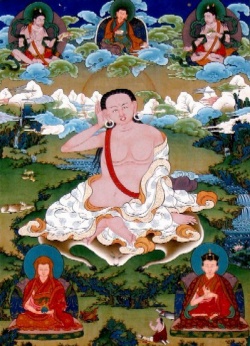Difference between revisions of "Dharma Theory. Introduction"
(Created page with " Dharma probably is the most significant term that we should understand, when we want to understand the Buddhist philosophy. You probably have seen statements like...") |
|||
| Line 1: | Line 1: | ||
| − | + | <nomobile>{{DisplayImages|255|3286|3250}}</nomobile> | |
| + | |||
| + | |||
| + | [[Dharma]] probably is the most significant term that we should understand, when we want to understand the [[Buddhist philosophy]]. | ||
You probably have seen statements like “[[Buddha dharma]]”, “go for a [[refuge]] to [[Buddha]], [[Dharma]] and [[Sangha]]”, or if you [[love]] to read [[books]], you may find that “all [[dharmas]] are [[empty]]”. What does it mean? | You probably have seen statements like “[[Buddha dharma]]”, “go for a [[refuge]] to [[Buddha]], [[Dharma]] and [[Sangha]]”, or if you [[love]] to read [[books]], you may find that “all [[dharmas]] are [[empty]]”. What does it mean? | ||
Latest revision as of 09:59, 26 October 2015
Dharma probably is the most significant term that we should understand, when we want to understand the Buddhist philosophy.
You probably have seen statements like “Buddha dharma”, “go for a refuge to Buddha, Dharma and Sangha”, or if you love to read books, you may find that “all dharmas are empty”. What does it mean?
All Buddhist traditions and schools of thought are classified according to their views on dharma. It is tremendously important to really understand, what is meant by dharma. Because all the later Buddhist philosophy and to some extent also practise is built upon the understanding of dharma. The explication of well-known 4 Noble Truths tells us, what Buddha discovered was: existence of dharma, causality and dependent origination of dharma and ceasing of dharma.
When Buddha himself was asked what he understands with words “All exists” he replayed: “All exist means 12 āyatana exists.” (12 groups of dharma). Division to āyatana is only one of the few possible dharma classifications. By “dharma” here are meant the smallest elements from which all that exists consists. All the so called external world along with all inner or psychic world, such as perception, consciousness, psychic powers and so on was researched and classified into dharma groups or we may say elements of existence.
The dharma theory on most part has been explained in the third part of Buddhist Canon – called Abhidharma. But nowadays it is mostly researched and taught according to a later work of Buddhist teacher and philosopher of 5th century Vasubandhu and his work “Abhidharmakosha”. Abhidharmakosha of Vasubandhu is considered a classical work where he systematized and explained all Abhidharma teachings that was contained in the Buddhist Canon and the earliest Buddhist tradition. Vasubandhu stressed that there is no other radical method to liberate oneself from the flow of affects and affective states of mind that bring all sufferings as a knowledge and differentiation of dharmas.
According to Vocabulary, the Sanskrit word Dharma may have a number of meanings as “Law”, “Religion”, “Attribute” and others depending on context.
Etymologically the word has originated from the root “dhar-” – “to carry”. Basically, Dharma means “Carrier” or “what is carried” like in the meaning of “quality”.
The main and probably the earliest meaning of the term, which is found in philosophical tractates and Sūtras, is where by dharmas are meant “Carriers” or really existing, unknowable substrates of elements to which in abstraction is divided all flow of the conscious life, i.e. the subject and all the life he perceives – both external and inner.
The essence of each dharma is transcendental and unknowable, only the dharma qualities or manifestations are creating the flow of conscious life. Thus, elements, to which the conscious is divided, are not dharmas themselves, but manifestations of dharmas. However to make it short and simple the word “dharma” is often used instead of “manifestation of dharma”; if this is the case, we can use a word “element” for “dharma”.
According to the earliest Buddhist tradition there are 75 dharmas or primordial elements.
Between the many dharmas there is one dharma which is very important for the liberation and is mentioned first of all. It is the element of cease or liberation itself – Nirvana. And because, according to the Buddhist philosophy, the goal of existence is the eternal cessation or eternal peace, this dharma is sometimes called the highest dharma or dharma per excellence. For this reason “dharma” often is a synonym of Nirvana.
At last, the term “dharma” means “the teaching of Buddha”. We have to point out, that very often in a statements like “Teach the Dharma”, “make offerings to Dharma”, refuge formula “Buddha, Dharma, Sangha” and others, “dharma” often is not a teaching itself, but the objective of the teaching – the Nirvana or Liberation. However in the popular Buddhism in those cases it is understood more simply – as a teaching, scriptures and Buddhist literature.
In many later, especially Mahayana, scriptures you can find a statements “all dharmas” or “the flow of dharmas” – where it is meant in the sense of “all things that are in the world” or “all phenomena that are in the world.”
Researchers say the term “dharma” can be found in the following meanings:
Quality, attribute, predicate
Substantial carrier, the transcendental substrate of the separate element of the conscious life.
Element, i.e. phenomena of the conscious life.
Nirvana, “Dharma per excellence”, the goal of the Buddha Teaching.
The Absolute reality, “that which is really existing”.
The Teaching of Buddha, religion.
A thing, object, phenomena.
Usually to differentiate in what sense to understand the term “dharma” in a particular situation you can by looking into context and a type of treatise.
Dharma is not only things, beings, phenomena, but also each thought, feeling or construction of the mind, if the subjects mind is aware about them.
This was a short introduction in dharma theory. I plan to write more about dharmas and Buddhism philosophy.


